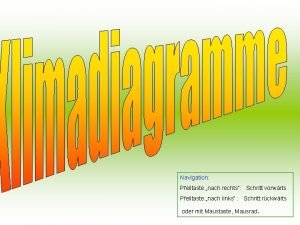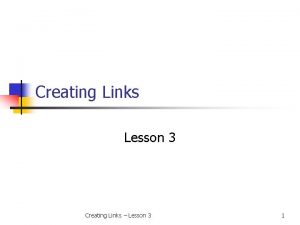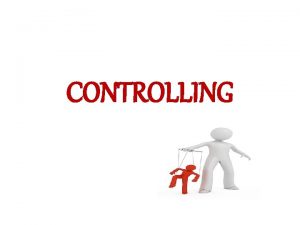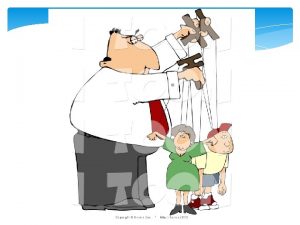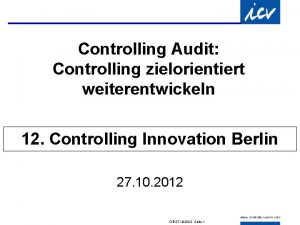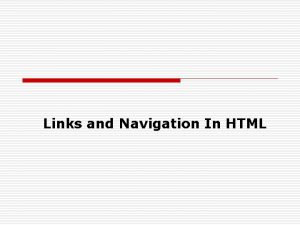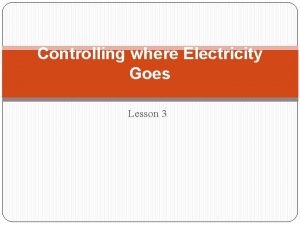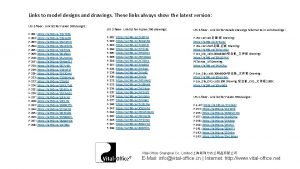CONTROLLING Lesson 9 LINKS OF CONTROLLING and other





















- Slides: 21

CONTROLLING Lesson 9

LINKS OF CONTROLLING and other Management Functions PLANNING ORGANIZI NG CONTROL LEADING CONTRO LLING

TYPES AND STRATEGIES OF CONTROLS �Preventive Control- takes place prior to the performance of an activity. A preventive control prevents that result from deviation from performance standards.

�Concurrent Controls- monitor activities while thy are carried out. �Feedback Control- evaluate an activity after it is performed.

Preventive Control Establishes standards to prevent problem Concurrent Control Measures Activity when performed Feedback Control Measures Final Activity

�External Control Strategy- is based on the belief that employees are primarily motivated by external rewards and must be controlled by their managers. �Internal control strategy- is based on the belief that employees can be motivated by building their commitment to organizational goals.

�Internal Control Strategy- an approach to control based on the belief that employees can be motivated by building their commitment to organizational goals

STEPS IN THE CONTROL PROCESS

Setting Appropriate Performance Standards �A standard is a unit of measurement used to evaluate results. Standards can be quantitative, such as cost of sales, profits, or time to complete an activity.

Measuring Actual Performance �Performance evaluations are one of the major ways of measuring performance

Important conditions for effective performance measurement: Agree on the specific aspects of performance to be measured. 2. Agree on the accuracy of measurement needed 3. Agree on who will use the measurements. 1.

Comparing Actual Performance to Standards �Key aspects of comparing performance to standards include measuring the deviation and communicating information about it. �Deviation- in a control system indicates the size of the discrepancy between performance standards and actual results. .

Taking Corrective Action �Do nothing- no corrective action is required if the evaluation reveals that events are proceeding according plan. �Solve the problem- if a manager decides that a deviation is significant he or starts solving the problem �Revise the standard- deviations from standard are sometimes attributable to errors in planning rather than to performance problems.

NON BUDGETARY CONTROL TECHNIQUES

Qualitative Control Technique �A method of controlling based on human judgments about performance that results in a verbal rather than numerical evaluation

Quantitative Control Technique �A method controlling based on numerical measures of performance

BUDGETS AND BUDGETARY CONTROL TECHNIQUES

�Budget- is a spending plan expressed in numerical terms for a future period of time.

Types of Budgets �Fixed budget- allocates expenditures based on a onetime allocation of resources. �Flexible budget- allows for variation in the use of resources on the basis of activity.

Suggestions for Preparing a Budget �Leave wiggle room- be optimistic but be realistic. Budget conservatively for income and liberally for expenses �Research the competition- do some fact finding to determine how your competitors at other firms arrive at their budget estimates

�Embrace Reality- study the facts carefully and take perspective in arriving at the correct estimates for any given financial period �Do not neglect intuition- past experience is important so as intuition
 Link and joint
Link and joint What is formal links in discourse analysis
What is formal links in discourse analysis Doodle fiction examples in the philippines
Doodle fiction examples in the philippines Global links and imperialism
Global links and imperialism Other initiated other repair
Other initiated other repair Lesson 5 solving square root and other radical equations
Lesson 5 solving square root and other radical equations Louisiana immunization links
Louisiana immunization links What is the logical view of data
What is the logical view of data Midland isd staff links
Midland isd staff links Slim jim sasquatch
Slim jim sasquatch Periodic movement definition ap human geography
Periodic movement definition ap human geography Everything that is alive needs energy
Everything that is alive needs energy How to write links in apa format
How to write links in apa format Reciprocal link means
Reciprocal link means Vorne hinten links rechts
Vorne hinten links rechts Copy all links
Copy all links Nide dropbox links
Nide dropbox links 3 fasige asynchrone motor
3 fasige asynchrone motor Vorne hinten links rechts
Vorne hinten links rechts Missing links quiz questions answers
Missing links quiz questions answers Power point links
Power point links Power point links
Power point links














